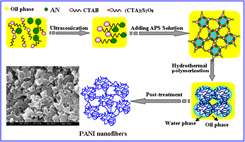Article contents
Interconnected polyaniline clusters constructed from nanowires: Confined polymerization and electrochemical properties
Published online by Cambridge University Press: 24 September 2014
Abstract

By using microemulsion-mediated solvothermal method in the presence of camphorsulfonic acid as a dopant, self-aggregated polyaniline (PANI) nanowires were synthesized and further organized into three-dimensional cluster-connected networks. So-formed PANI exhibited a hierarchically porous structure, which was significantly different from those obtained by conventional chemical oxidation method, hydrothermal method, and other reported methods. Compared with nanofibers presented in this study, the nanowires in the clusters had a great decrease in diameter from ∼60 to ∼15 nm due to the space-confined polymerization. In addition, the size of the clusters could be easily adjusted by altering the dopant/monomer molar ratio. A probable assembly mechanism for such an interesting morphology was proposed. Used as an electrode material, PANI clusters showed high specific capacitances (510 and 368 F g−1 at 0.5 and 2 A g−1, respectively) and improved cycling stability (66% capacitance retention over 1000 cycles) as compared to PANI fibers and particles obtained by other methods, which may be related to its unique morphology and high doping level.
- Type
- Articles
- Information
- Copyright
- Copyright © Materials Research Society 2014
References
REFERENCES
- 6
- Cited by


